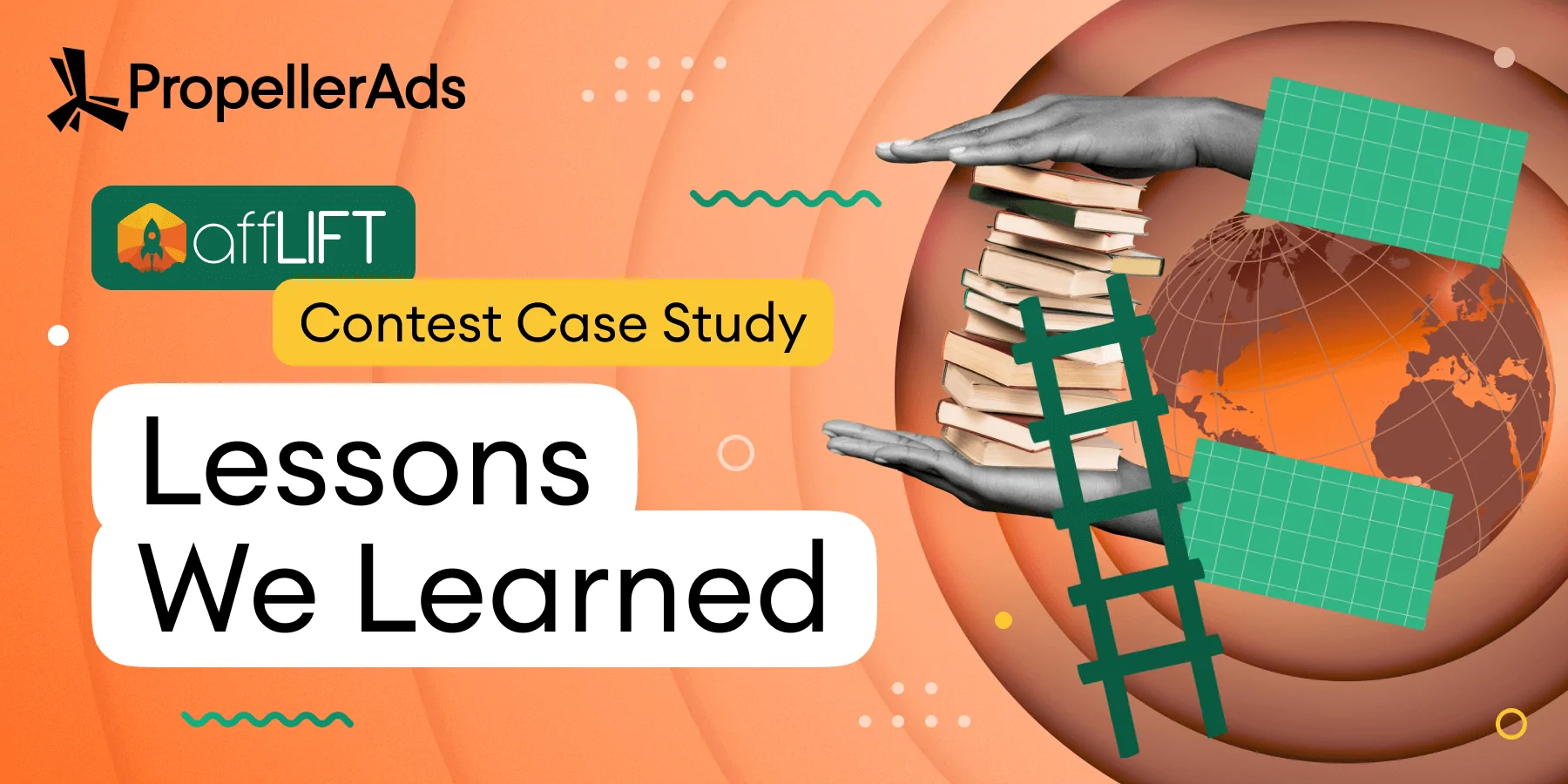4 Campaign Strategy Lessons We Learned From AffLift Contest Case Study

This post is also available in:
PT
ES
Launching and optimizing campaigns is all about gaining profits. It’s the end goal. And the size of the gap between how much you invested and how much you earned at the end of the road will determine how successful your campaign was.
But money is not all you can acquire from such a ride. We won’t pretend like it doesn’t matter – it clearly does, it’s business, after all. But lessons you can learn from running a campaign can significantly improve your affiliate skills and lead you to some new victories in the future.
This case study is from the Follow-Along contest PropellerAds organized together with the AffLift forum, and it won many votes based on its insightfulness. Together with Valerii Puzankov, our Senior Account Strategist, we analyzed all the moves Nick, the affiliate marketer, made behind this case, and we laid out some conclusions you might find useful.
Basic information about the case
| Traffic Source: | PropellerAds |
| Tracking Tool: | Custom |
| Type of Offer: | CPL |
| Pricing Model: | CPA Goal |
| Ad Formats: | Popunder, Push Notifications |
| Offer Payout: | From $0.20 to just over $1 |
Bear in mind that the contest participant whose case we are about to analyze was in a mood to experiment with different approaches when running a campaign.
“I’m not sure if some of the things I’m going to try are even going to work. I’m about to run some offers, verticals, and ideas that I have never run before.”
Multiple landers in focus: The first campaign strategy
Our affiliate started his Follow-Along journey with a campaign on a hot offer by using 14 of his landers. Based on a suggestion from a couple of Account Managers, including his own, he decided to use some Sweepstakes-inspired landers that were still relevant to his mVAS (Mobile Value Added Services) offers.
However, the majority of his landing pages were still more aligned with the vertical he was running.
“I launched the CPA Goal campaign targeting what the offer required and I only blocked the lower Android OS versions because they tend to have no volume.”
Marketer’s first conclusions: “One landing page is performing way better than the rest of them. The Sweepstake landers also do convert, but not really any better than the “regular” converting landing pages”.

LESSON #1

Generally, the 14-landers split test is awesome, it’s a good idea to test as many creatives as possible. But if you have just 2-3 different landing pages, it would be better to follow the rule → 1 landing page per 1 campaign test, since the CPA Goal campaign does its optimization based on the CR of each traffic slice.
If you split test a lot of landing pages in one campaign, you could get very mixed results, and it probably won’t have enough eCPM to stay live and provide profit down the line. So remember, if you are going with the CPA Goal bidding model, make sure to have 1 landing page per 1 campaign.
The language of landing pages as a huge factor to consider
The very first line in the statistics above represents the landing page that was done in English. Now, why is this important? Because this GEO has English as the official language, but the majority of the population is using a different language (which is considered to be the main one among population).
So, the affiliate wanted to run one lander in English, and one in the most used language to show how translation can affect the campaign performance. He also decided to run a duplication of the best-performing landing page in English to see if the same thing would happen.
LESSON #2:The affiliate made a fair point. The native language lander should work better in the majority of cases! The probability that the most spoken language will make more money over time is super high. So don’t be lazy, put in the research and translate your landing pages.
But pay attention to the browser language stats as well. Maybe this EN landing page would have worked better on the EN browser language campaign.
Relaunching: New rounds of tests
All red landers that didn’t convert were cut, and the marketer relaunched the campaign with eight landing pages (the seven that converted + the best-performing landing in English).

The campaign did not convert as well as the first time, but it was winning a larger percentage of the traffic. It became clear to the marketer that he needed to focus on only one lander – the one that showed the best results in the first round of tests.
So he launched the campaign one more time, but now with only that particular landing in both English and the main language of this GEO. Below, you can see the comparison:

The green line highlights the landing page in the most spoken language in this country. The orange line is the English version, which is the primary language, but not as preferred by most of the population.
As you can see, this confirms the conclusions we made under Lesson #2.
Unfortunately, in the end, the marketer understood that this campaign had no scaling potential, even though he launched it again with only one landing that performed the best.
LESSON #3:
You need to be careful with the mVAS offers, given that many GEO/carrier combinations don’t have enough volume to make running the campaign worth it.
In this case, as the affiliate explains, the profits would be unsatisfying even if he invested more money.
Playing with strategies: Conversion event in focus
Our affiliate decided to shift to other verticals and another GEO in order to test a bunch of new offers. The offers were somewhat similar, but they had varying payouts from around $0.20 to just over $1.
Once again, he went with the CPA Goal bidding model, but with a new strategy: to set the most simple action possible as a conversion event – click on a landing page or a specific button on a landing page.
So he launched a Push campaign and a Popunder campaign relying on this strategy. It was for the sake of science, as the marketer explained, and he didn’t know what to expect. He did hope, however, that this would bring more stable campaign performance and more volume down the line.
Note: Both campaigns were using the same landing pages, and they were based on the same offers and in the same GEO.With the Push campaign, the affiliate bid the minimum ($0.01 per LP click) and slowly increased it up to $0.03. An interesting thing he noticed is that landers with the most simple conversion event had higher CTR, but didn’t convert as well:

His conclusion was this: “I need high CTR landing pages, but they also need to convert. So I can’t just have high CTR LPs (the ones with simple conversion events) because they’re not converting well enough.”
The results from his Popunder campaign were not as conclusive, but he did get data that the simple event conversion LP he was running was actually producing the best EPV (earnings per visitor).

Finally, he launched one more Push campaign, he set everything the same as with the previous Push campaign, but this time, he placed as a conversion event a more demanding action – a registration instead of a simple click on a landing page.

Even though neither of these three campaigns fulfilled the expectations of our affiliate, he ended up with another conclusion →
LESSON #4:
The unsatisfying campaign results don’t mean your approach or your strategy is wrong. In this case, the affiliate was intentionally making moves just so he could test his theses, but as you know, the results depend on multiple variables.
The theory behind the marketer’s strategy – to launch campaigns based on the simplest conversion event – proved to be correct.
He claims that the Push campaign with this strategy performed better compared to the Push campaign he launched at the end, where the conversion event was a bit more complex. In fact, he says that it had more volume and three times higher eCPM.
Extra insight: How does the CPA Goal bidding model work?
In his last Follow-Along update, the marketer expressed uncertainty regarding the CPA Goal bidding model – how it works.
What he suspected is that the campaign strategy performance is determined by bid + CR combinations, and he was absolutely right. Our account strategist confirms this, and explains:
“To get more volume for your campaign, you should focus on improving your conversion rate and your bid, if possible. And if you are not getting enough traffic, or your campaign dies pretty quickly, it showcases that your bid was off, or that your CR was not high enough, or it was the combination of both.”
To conclude
Despite all the effort invested in these campaigns not bringing much profit to our affiliate, he said he felt like a winner after all. And we agree.
With this Follow-Along journey, he gained new experience, a new perspective, some confirmations, and he shared it with his fellow affiliates. The amount of details he included and his analytical approach were the reasons why engagement on his thread was tremendous.
We thank this marketer for being a team player, and we hope you find the lessons we pointed out useful.



